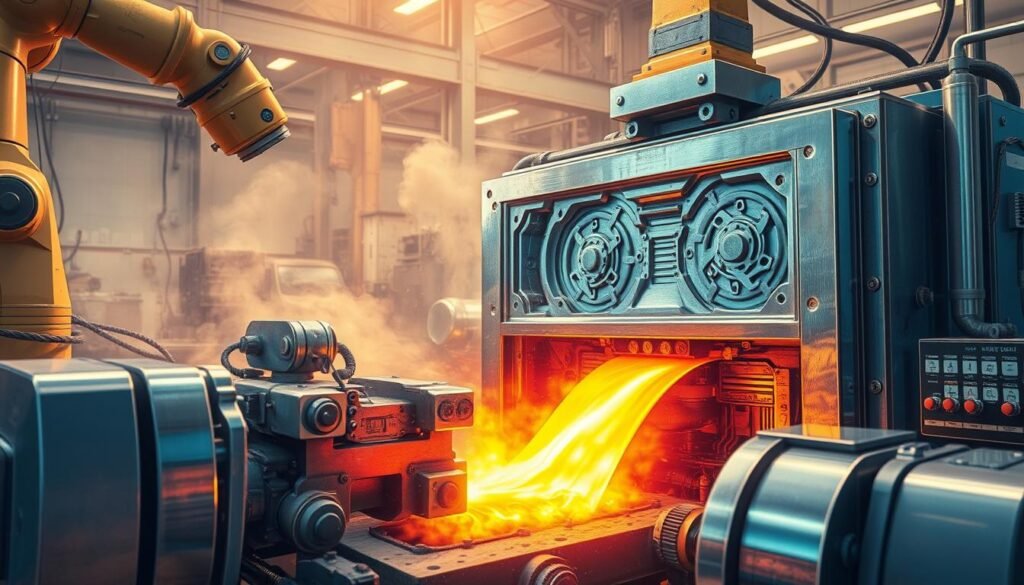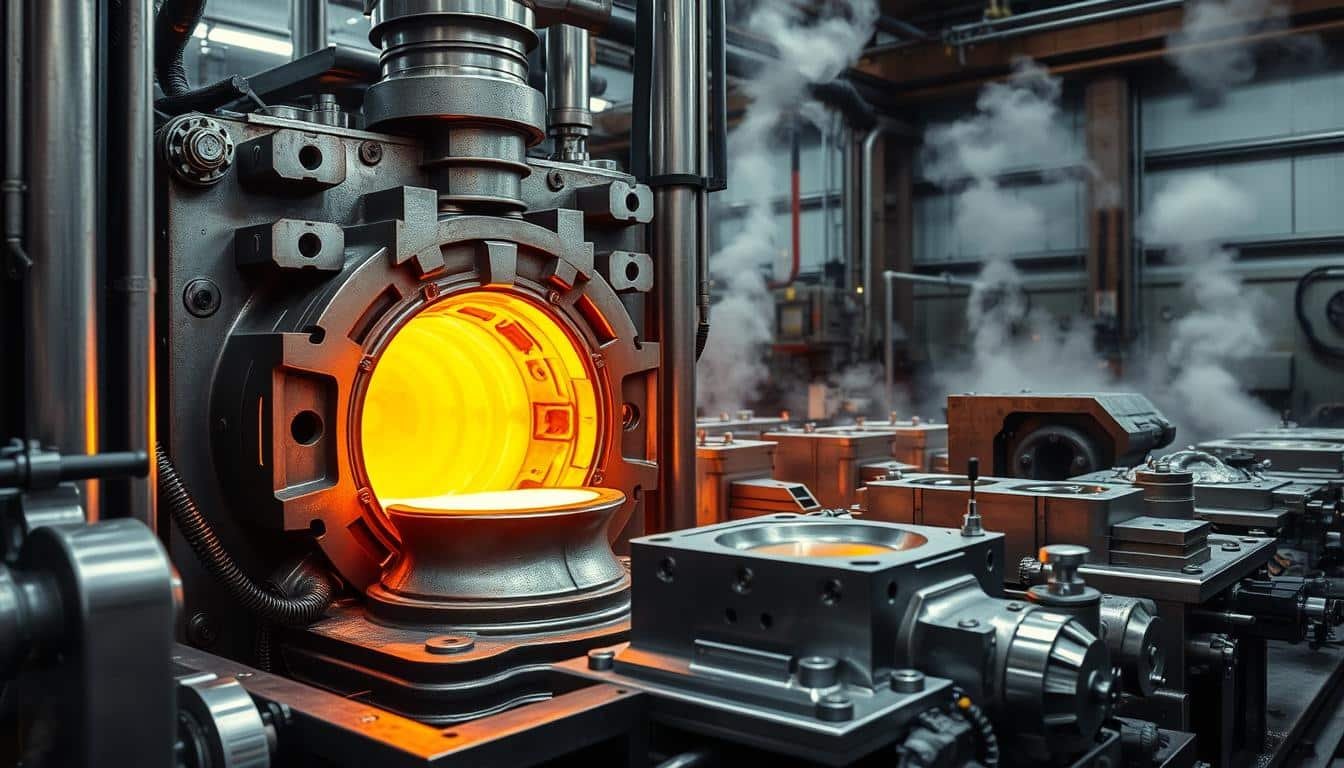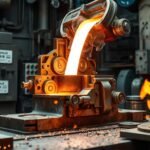Ever wondered how everyday products are made so precise and versatile? The secret might be in die casting aluminum. This method has changed how we make complex, high-quality metal parts. It’s a technology worth learning more about.
So, what is die cast aluminum, and how does it differ from other methods? What makes it a top choice for so many industries? Find out in this detailed guide to die cast aluminum.
Key Takeaways
- Die casting is a high-pressure process that quickly makes complex, smooth metal parts from molten aluminum.
- Die cast aluminum parts are light, resistant to corrosion, and great at conducting heat and electricity.
- Common alloys used include A380, 383, B390, A413, A360, and CC401. Each has its own benefits and uses.
- Die casting gives parts that are accurate, have great finishes, and need little extra work compared to other methods.
- The process is perfect for making lots of aluminum parts cheaply. It’s used in cars, industry, and telecom.
What is Diecast Aluminum: Understanding the Basics
Diecast aluminum is a versatile material used in many industries. It has unique properties that make it a top choice for many applications. It’s known for its stability, resistance to corrosion, and strength-to-weight ratio. It also conducts electricity well, making it stand out among metals.
Properties and Characteristics of Die Cast Aluminum
Diecast aluminum keeps its shape and size well, even in changing environments. This is great for applications where exact sizes are needed. It also resists corrosion well, keeping parts strong and lasting longer.
Common Aluminum Alloys Used in Die Casting
The die casting process uses different aluminum alloys. Each alloy has its own benefits. For example, A380, A390, A360, A413, ADC-12, and ADC-1 offer strength, hardness, and better casting and machining. These make them good for many uses.
Key Advantages of Aluminum Die Casting
- Lightweight and durable parts
- Excellent surface finish
- Good tensile strength
- Low-cost raw materials
- Ability to produce complex shapes with thin walls
- Reduced porosity and impurities for dimensional tolerance and airtightness
- Ability to withstand high operating temperatures and offer RFI and EMI shielding properties
The aluminum die casting industry is growing. In 2019, it was worth $50.5 billion in the U.S. It’s expected to grow 6.4% each year from 2020 to 2027. This growth is because of its versatility, cost, and wide range of uses in many industries.
The Die Casting Manufacturing Process

Aluminum die casting is a key process in making high-quality parts for many industries. It’s used in cars, medical tools, and more. This method is fast and precise, creating parts with great detail and speed.
The first step is preparing the steel die. It’s heated to 150-300°C and coated with a special agent. Then, molten aluminum alloy, like A380, is heated to 650-750°C. It’s moved to the die casting machine’s shot sleeve.
High pressure, 10-175 MPa, pushes the molten metal into the die cavity. It fills complex shapes quickly. After cooling, the part is ejected. It might need more work like trimming or machining to meet needs.
Quality checks are done at every step. This ensures the parts meet standards like ASTM B85/B85M and ISO 2768. This focus on quality makes aluminum die casting great for diecast metal manufacturing and die casting automotive parts.
| Region | Aluminum Die Casting Market Value (USD Billion) | CAGR (%) |
|---|---|---|
| Asia Pacific | $22.67 | 5.3% |
| Europe | $9.45 | 5.1% |
| North America | $4.22 | 4.9% |
The die casting industry is growing fast. The Asia Pacific region is leading, expected to hit $22.67 billion by 2025. Europe and North America will also see big growth, with CAGRs of 5.1% and 4.9%, respectively.
“Aluminum die casting can produce high-quality parts within seconds, making it a highly efficient manufacturing process for creating near-net-shaped parts.”
Conclusion
Die cast aluminum is a versatile and innovative material. It offers a unique mix of properties that make it popular in many industries. Its strength, thermal conductivity, and cost-effectiveness are just a few reasons why it’s in demand.
The die casting process has improved a lot. New alloys and production techniques have been developed. This ensures high-quality parts that meet strict standards, like IATF 16949.
The aluminum casting market is growing fast, with a 6.4% CAGR from 2020 to 2027. Die casting’s versatility and cost-effectiveness will make it even more appealing to manufacturers worldwide. It’s perfect for creating intricate, durable, and beautiful parts, shaping the future of manufacturing and design.
FAQ
What is die cast aluminum?
What are the key properties of die cast aluminum?
What are the common aluminum alloys used in die casting?
What are the advantages of aluminum die casting?
What are the steps in the aluminum die casting process?
Source Links
- What is Aluminum Die Casting? 5 Things You Need to Know – https://www.gabrian.com/what-is-aluminum-die-casting/
- Aluminum Die Casting Alloys | Aluminum Casting | Dynacast – https://www.dynacast.com/en/knowledge-center/material-information/aluminum-die-casting-metals
- Aluminium Die Casting Guide | Get It Made – https://get-it-made.co.uk/guides/aluminium-die-casting-guide
- What is Die Casting: Process, Types, Advantages and Applications – https://www.3erp.com/blog/die-casting/
- What is Aluminum Die Casting? The Process of Die Casting – PHB Inc. – https://www.phbcorp.com/what-is-aluminum-die-casting/
- What is Aluminum Die Casting? — Chicago White Metal Casting, Inc. – https://cwmdiecast.com/what-we-do/die-cast-metals/aluminum-die-casting/
- Die casting – https://en.wikipedia.org/wiki/Die_casting
- Aluminium Die Casting: Essential Insights for Engineers – https://www.wevolver.com/article/aluminium-die-casting
- Aluminum Die Casting: A Comprehensive Guide on Die-Cast Aluminum Process – https://www.rapiddirect.com/blog/aluminum-die-casting/
- Difference Between Cast Aluminum Vs. Die Cast – Zetwerk – https://www.zetwerk.com/resources/knowledge-base/die-casting/difference-between-cast-aluminium-die-cast/








Interesting read, but isnt the use of aluminum alloys in die casting also dependent on cost-effectiveness?
Interesting read but isnt it high time we explore sustainable alternatives instead of glorifying die-cast aluminum? Just a thought.
So, were praising die cast aluminum now? Ever thought about its impact on the environment? Lets discuss that too, pals.
Interesting read! But dont you think stronger alloys should be explored more in die casting, not just aluminum?